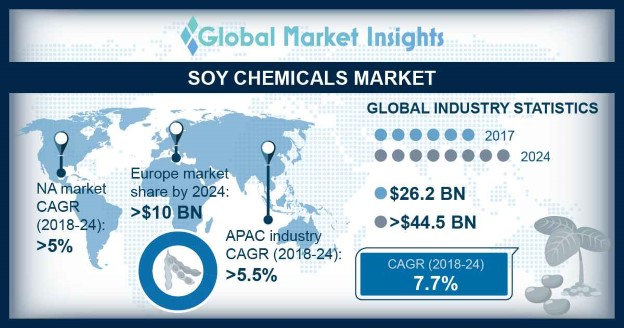Home > Chemicals & Materials > Biobased Chemicals > Soy Chemicals Market
Soy Chemicals Market Size
- Report ID: GMI2973
- Published Date: Oct 2018
- Report Format: PDF
Soy Chemicals Market Size
Soy chemicals market size exceeded USD 25 billion in 2017, registering a CAGR of 7.7% through 2024 and expects consumption of above 6.5 million tons by 2024. Rising demand for biodegradable products along with supportive government initiatives owing to shifting consumer preference towards renewable chemical sources may fuel the market demand. Rapid urbanization along with booming food and agriculture industry mainly in China, Japan and India may further support product demand.
Global cosmetics products was valued at over USD 500 billion in 2017 on account of rising aging population & image consciousness along with changing lifestyle patterns and increasing trend of online purchasing. Soybeans comprises of high concentrations of phytosterols, minerals, vitamins, isoflavones, saponins and isoflavones. Soybean products are rich in protein, iron, calcium and zinc thereby providing several skin benefits such as wrinkle repair, hair growth, acne reduction along with boosting immunity and skin rejuvenation which may promote the soy chemicals market demand.
Soy based chemicals incorporated in food & beverages are used as additives or ingredients as these products enhance the nutritional value of food items by boosting protein content. The global soybean industry stood at over USD 145 billion in 2017 and is expected to register maximum gains as these products are good sources of vitamins, minerals and insoluble fiber and helps in aiding diseases such as osteoporosis, breast cancer, Type 2 diabetes, fetal development along with lowering cholesterol level, improving energy and weight management thereby promoting the soy chemicals market growth.
| Report Attribute | Details |
|---|---|
| Base Year: | 2017 |
| Soy Chemicals Market Size in 2017: | 25 Billion (USD) |
| Forecast Period: | 2018 to 2024 |
| Forecast Period 2018 to 2024 CAGR: | 7.7% |
| 2024 Value Projection: | 44.5 Billion (USD) |
| Historical Data for: | 2013 to 2017 |
| No. of Pages: | 480 |
| Tables, Charts & Figures: | 732 |
| Segments covered: | Product, and Region |
| Growth Drivers: |
|
| Pitfalls & Challenges: |
|
Rising demand for sustainable energy sources has led to increasing adoption of biodiesel majorly in North America which are produced from soy oil feedstock such as soybeans, animal fats and recycled edible oil. Bio diesel emits lower levels of particulate matter and carbon monoxide as compared to conventional petroleum bio-diesel. More than 50 percent of bio-diesel in the U.S. is manufactured using soy oil as it is renewable, less toxic, economic and provides GHG reductions. According to The United States Department of Energy, the usage of bio-diesel provides approximately 78% reduction in the CO2 emissions thereby promoting the soy based chemicals market demand.
Rising soybean allergies occurring from the consumption of various products such as soy milk, cheese, tofu, yoghurts and textured proteins may hamper the business growth. The allergy symptoms of consuming these products includes abdominal pain, skin redness, hivers and diarrhea. Additionally the U.S. food allergen labeling law requires all packaged food to state if the products contains top 8 allergen including soy which may cause hinderance for soy chemicals market growth.

